Liquidswap LSD token first airdrop
This article will cover the details and methodology of the first airdrop of LSD to users of the Liquidswap protocol.
 JinseFinance
JinseFinance
Author: Trustless Labs Source: X, @TrustlessLabs
Babylon is a non-custodial Bitcoin staking solution. It implements the native asset staking of the BTC layer in a cryptographic trustless way, and provides POS security guarantees for other blockchains through re-staking to generate income.
Bitcoins pledged by Babylon will not leave the main network. Security is guaranteed by the PoW mechanism. The staking process is completely operated in the cryptographic way of "extractable one-time signature EOTS" and does not rely on any third-party bridge or custodian. Therefore, it has also been sought after and welcomed in the BTC community, which has extremely high security requirements.
Babylon allows Bitcoin holders to obtain staking interest income while ensuring security, opening up the BTC staking track and completely changing the gameplay of the BTC ecosystem. At the same time, the introduction of staking BTC can also solve the problems of inflation of small and medium-sized POS chains (if you want to convince everyone to Stake, you have to provide relatively high inflation returns, such as staking for a year to get 10~15% or even 20% of the token) and difficult start-up (building a verification node requires a lot of money).
Similar to ETH's traditional liquidity token solution, the BTC liquidity staking solution wants to be a BTC demand deposit, which can be deposited and withdrawn at any time and pay you interest, and the liquidity staking token can also be used to obtain income from other DeFi projects (such as providing liquidity, lending, etc.). Users staking on Babylon can be regarded as a fixed deposit, which has high returns but cannot be withdrawn in time.
At the same time, more non-mainnet BTC users can be introduced. For example, users holding wBTC on Ethereum can also participate in Babylon staking.
Liquidity staking can essentially be regarded as the project party borrowing the user's BTC to pledge in Babylon, using the staking income to pay the user's interest, and the bonds (liquidity pledge tokens) given to the user can also be traded.
Currently, most of Babylon's liquidity pledge tokens are built on Ethereum, and plans to support multiple chains in the future. Except for Lombard, which is directly pledged to Babylon by users, other projects adopt a custodial model, where the project party pledges to Babylon on behalf of the user, and liquidity is provided by a third-party institution.
pSTAKE adopts institutional custodial liquidity. The user's funds are pledged to the Pstake storage address. The liquidity is supported by institutional custodial providers such as Cobo. The project party then pledges BTC to Babylon.
yBTC is the official liquidity pledge token. It has not yet been issued. It is expected that users can use yBTC to obtain income on other DeFi projects, such as providing liquidity, lending, etc. yBTC will be issued on Ethereum at first, and then on other L2.
The content of the v1 testnet is to use sBTC (BTC on the testnet) to deposit and withdraw on pSTAKE on the BTC testnet. V2 provides users with the function of obtaining staking income from Babylon on the mainnet. V3 will mint a liquid staking token called yBTC, so that users can use yBTC to participate in other DeFi projects while obtaining staking income. V4 makes the income more diversified.
The product is currently in the v1 stage and has not yet launched a points plan. It is expected to be launched together with the main network. Participating in the test network staking will bring additional points. Currently, 44,813 users have participated in v1 and pledged 40.65 sBTC.
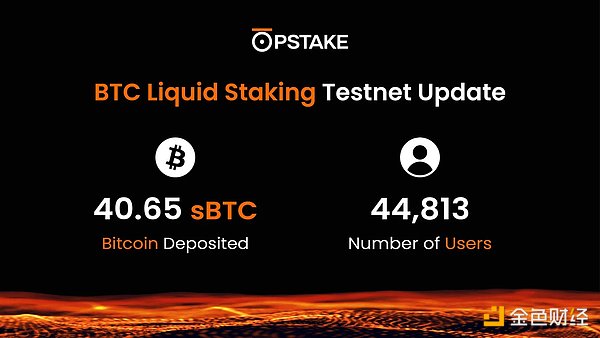
Lorenzo has implemented a principal and interest separation business similar to Pendle on the BTC liquidity solution.
Users send BTC to Lorenzo's multi-signature wallet, which is then held by a staking agent (a group of trusted Bitcoin institutions and TradFi giants) and receives stBTC as a staking certificate. Lorenzo then pledges BTC to Babylon.
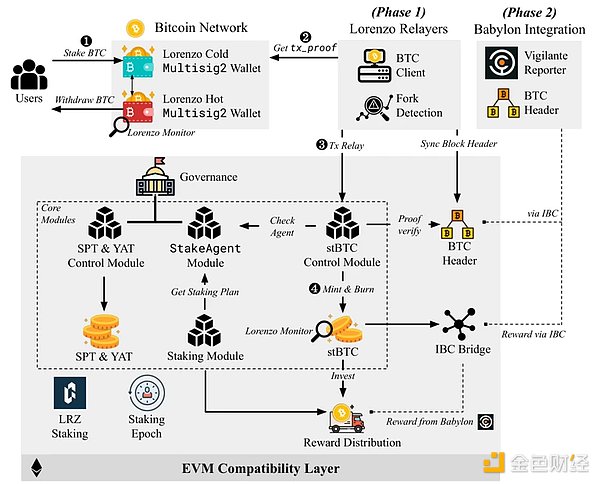
After pledging Bitcoin liquidity, Lorenzo issues three types of tokens:
Liquidity Principal Token (LPT): represents the tokenization of redeemable BTC principal, of which stBTC is Lorenzo's official LPT
Yield Accumulation Token (YAT): represents the right to claim income from the staking project at the end of the re-staking period. YAT can be traded and transferred, and cannot be transferred after expiration. Users can claim project rewards based on the YAT they hold. YAT is an ERC-20 token issued by re-mortgaging to a staking agent.
Staking Proof of Stake Token (SPT): After users use YAT to claim project rewards, YAT will be automatically converted to SPT of equal value, enter a unified queue, and cannot be traded. The only purpose of SPT is to be destroyed in order when users destroy stBTC to withdraw BTC. The agentID associated with the destroyed SPT determines which staking agent will redeem BTC. If there are insufficient SPTs in the queue, users must wait for new SPTs to enter the queue. Users who generate SPT by claiming YAT can use their own generated SPT to redeem BTC first.
Since both LPT and YAT can be traded, anyone with YAT and LPT can use them to claim yield and withdraw re-pledged BTC, respectively.
LPT like stBTC can be seen as another form of wrapped Bitcoin, and Lorenzo aims to eventually replace wBTC. The value of YAT comes from accrued yields and speculation on future yields, and YAT has high volatility. The trading pair between stBTC and all YAT will be the base trading pair. There may also be trading pairs between LPT, YAT, and assets such as ETH, BNB, and USD stablecoins, creating huge arbitrage and investment opportunities for investors.
In the lending protocol, borrowers can use LPT and YAT as collateral to borrow any assets they want; in return, stakeholders have greater control over their investments and liquidity.
Lorenzo's mainnet will be launched in two phases (Lorenzo Phase One and Lorenzo Phase Two).
Lorenzo Phase One is mainly for testing the casting of stBTC from BTC and the exchange of stBTC to BTC.
Lorenzo Phase Two introduced a staking agent to decentralize the management of user staked BTC and issue BTC-backed liquidity re-staking tokens. The staking agent can issue YAT to represent the user's staking income. When users use YAT to receive project rewards, YAT will be automatically converted to an equivalent amount of SPT, which determines which staking agent will redeem BTC.
Perform pre-launch staking to earn income and points: https://app.lorenzo-protocol.xyz/staking
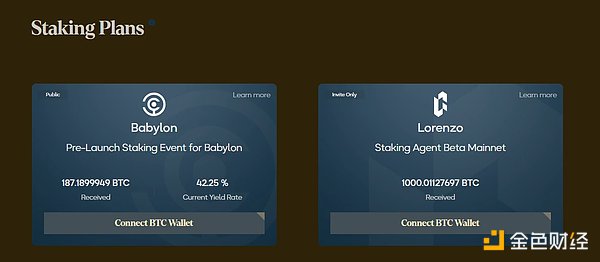
Lombard is more decentralized. User funds are directly staked to Babylon instead of being provided with liquidity by a trusted third party. The overall architecture consists of users, Bitcoin nodes, backends and Consortium (used to manage the staking process, which is a decentralized state machine that uses Raft The staking process of Lombard is managed by the decentralized Consortium. Users will send native BTC to the address of the Consortium. Once the backend monitors that there is a deposit at this address of the Bitcoin node, it will trigger the deposit notarization process to the Consortium. The Consortium will check the transaction to verify the deposit, then pledge BTC to Babylon and mint the number of LBTC pledged by the user.
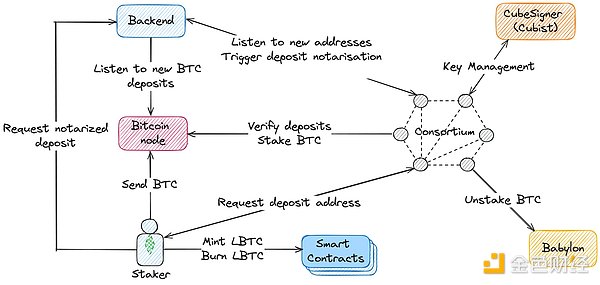
LBTC is Lombard's liquidity staking token, and holders can obtain native income through Babylon staking. LBTC is exchanged at BTC 1:1. LBTC can cross-chain and is compatible with DeFi. It can be used as collateral for lending protocols, perp DEX, etc. In the future, the first phase of LBTC will be issued on Ethereum, and then expanded to multiple chains.
Lombard is currently in Phase 1 and is running on the Ethereum mainnet in Private Beta mode. Eligible participants can stake native BTC and mint LBTC. It is worth noting that Lombard can only be staked but not withdrawn. You can continue to pay attention to the dynamics of X.
Phase 2 will begin in a few weeks and will open LBTC to the public while maintaining the deposit cap. The LBTC waitlist manages LBTC demand and provides us with a mechanism to reward early participants by giving them exclusive access and benefits over time.
LBTC waitlist: https://lombard.finance/#LBTC_waitlist
Solv tokenizes the Staking income and Restaking income from BTC Layer 2 (integrated with Babylon) and the DeFi income from ETH Layer 2 into SolvBTC. SolvBTC is seamlessly integrated with other protocols to deliver Bitcoin liquidity into various application protocols. Solv now supports Ethereum, BNB, ARB and Merlin.
Solv adopts a decentralized asset management architecture, including modules such as built-in security guards, price oracles, and tokens based on liquidity strategies, and establishes trustless process standards through smart contracts.
Solv also adopts a custodial model, and off-chain funds are held by reputable custodians.
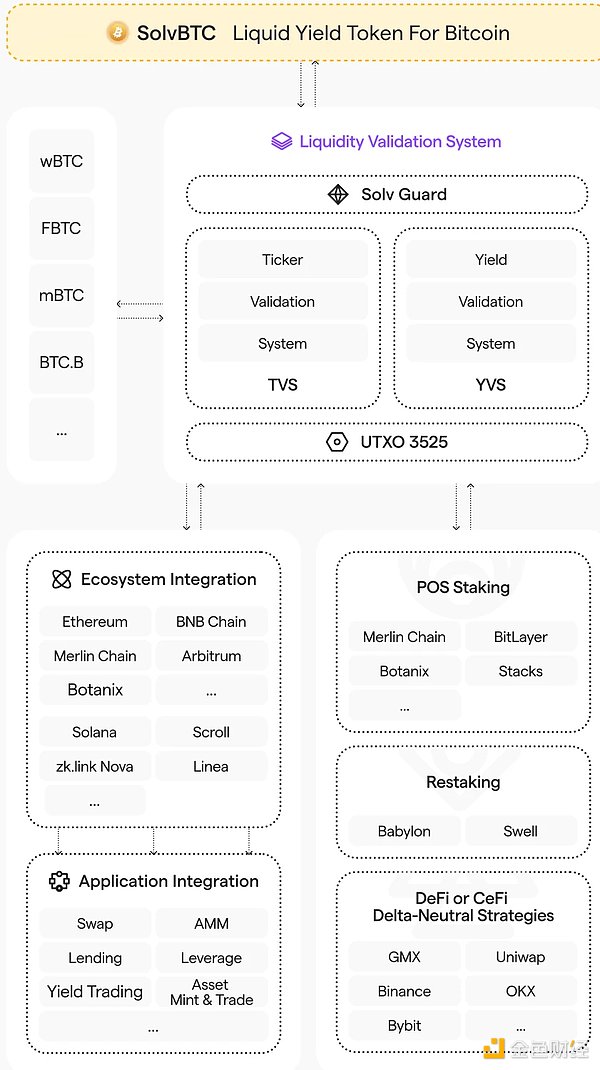
solvBTC.BBN is the official liquidity staking token of Solv and will be integrated with various DeFi protocols.
The roles include:
DEX: Provide instant liquidity and high-yield opportunities for solvBTC.BBN holders without KYC.
Lending Protocol: Allows solvBTC.BBN holders to stake tokens to earn extra income, while allowing borrowers to obtain leveraged income positions.
Yield Trading Protocol: Enables users to trade BBN's future income, manage income volatility, and optimize returns.
Since its launch in April, SolVBTC has attracted more than 12,000 Bitcoins pledged and 20,000 users participating on Merlin Chain, Arbitrum and BNB Chain.
Total points (XP) are composed of three parts, namely basic points, acceleration points, and referral points. Total points are the accumulation of three types of points
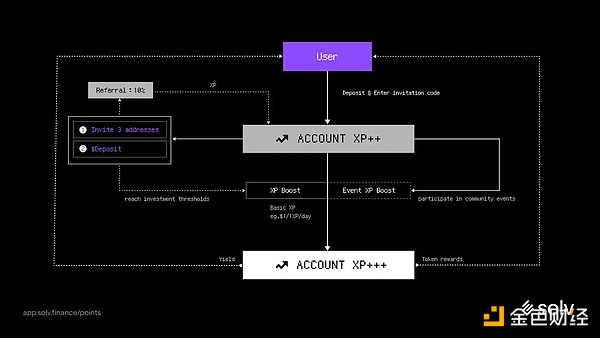
Basic points are obtained by depositing funds into Solv Vaults. The more users deposit, the more basic points they get. And the longer the deposit is held, the more basic points they get. Among them, basic points = (points per US dollar deposit) × (holding time) points are updated every day. The value of the pledged funds in the Vaults will be recorded in a snapshot every day. Note: SolvBTC purchased from the secondary market will not generate any points.
The unlocking condition of the acceleration card is to invite three real investment users, with no limit on the amount. In the end, your points = (basic points) x (acceleration card coefficient). There are two types of acceleration cards:
XP Boost: You can get it after reaching a certain investment threshold. The larger the amount, the greater the multiple. Everyone can see their own acceleration and the amount line to reach the next stage and the corresponding acceleration coefficient. Explore it on your own, which has a large marginal benefit.
Event XP Boost: Get it by participating in activities, with a time limit of 7 days, and multiple cards can be stacked. In mid-April, the system will display the acceleration card and the acceleration coefficient obtained in your card bag. There will be a new round of acceleration card airdrop activities in the future.
After users bring in new users, they can get 10% of the basic XP points (Basic XP) of the offline users, which does not affect the total score of the offline users; there is no limit, the more real users you bring in, the more you can earn.
As a liquid staking mechanism, Bedrock was originally developed for the Eigenlayer ecosystem, and then gradually developed into the largest staking entry on IOTX, and has obtained a total of nearly 200 million TVL in the ETH and IOTX ecosystems.
Recently, they were commissioned and technically supported by Babylon to develop the BTC liquidity pledge protocol UniBTC, which allows Ethereum users to pledge wBTC to Babylon. uniBTC is currently found on Ethereum.
Users can obtain Bedrock rewards and Babylon points by holding uniBTC. It should be noted that uniBTC cannot be unpledged yet, but uniBTC can be sold directly because it can be exchanged with WBTC 1:1.
Master Protocol is a revenue aggregation platform that aggregates BTC ecological projects such as Bouncebit (stBBTC), Babylon, BitLayer, etc., allowing users to pledge or trade through the platform.

Master Protocol's two main products:
Master Yield Market: Provides profit-making trading opportunities, aggregates Bitcoin ecological assets, packages them into MSY, and then splits them into MPT (principal) and MYT (interest) for users to trade.
LST Protocol on Botanix Spiderchain: Liquidity staking protocol, improves Bitcoin's liquidity and yield. Not yet launched, will cooperate with Botanix in the future
The basic function of Master Yield Market is to aggregate Bitcoin ecological assets, package them into MSY, and split them into MPT and MYT for users to trade. Its principle is similar to the Pendle protocol:
• MPT (Master Principal Token): represents the principal. Purchasing MPT can lock in the profit of the underlying assets in advance, which is equivalent to a fixed income product. Whales or institutions will like this low-risk product. The purchased funds will move to the LST protocol and BTC L2.
• MYT (Master Yield Token): represents interest. The unit price of MYT is low, but it can improve the utilization rate of funds, which is equivalent to leveraging and speculating on expected returns. This part of retail investors will prefer it, and the price will fluctuate.
Master Yield Pass is an incentive measure launched by Master Protocol, with a total of 10,000, which were minted for free on Base on June 24. At present, all NFTs have been minted for free. The rights and interests after staking Master Yield Pass include:
Get points from Trading Pool and Referral Pool in exchange for future token airdrops.
Platform fee dividends: Assuming the total transaction volume reaches $200 million and the platform fee reaches the million-dollar level, each NFT can get more than $100 in dividends. (In comparison, the cumulative transaction volume of Pendle, a yield trading platform on Ethereum, has reached billions of dollars.)
Future rights: such as whitelist qualifications for NFT/activities/IDO, etc.
Chakra is a ZK-driven shared modular Bitcoin settlement layer that provides unified settlement services for all second-layer networks, builds an aggregated liquidity and interoperability network, and releases Bitcoin liquidity to the entire chain ecosystem.
Chakra's funds on the Bitcoin network will be managed by the MPC solution service provided by Cobo, and then pledged to Babylon to obtain pledge income. After the transaction is retrieved and verified, tlBTC will be used as a pledge certificate, allowing the pledger to mint.
tlBTC corresponds to the number of BTC pledged on the Bitcoin network 1:1. tlBTC has three uses:
As a pledge certificate, users can enjoy the underlying Babylon's pledge income while holding it
As a liquid asset, users can invest it in the DeFi ecosystem (Dex, Lending, Stablecoin) to obtain additional income
As a native asset for full-chain settlement, it uses Bitcoin's good liquidity and stability to achieve high-efficiency, low-latency, and low-slippage settlement
Recently, we have launched joint test networks with Babylon many times, and have always ranked first in the three Cap stages. In the latest Testnet-4 Cap 3, Chakra, as the No. 1 Finality Provider of Babylon, has a total confirmed TVL of 258.401 sBTC (36% of Babylon's total TVL), and has received 171,142 pledge delegations (37% of Babylon's total pledge delegations).
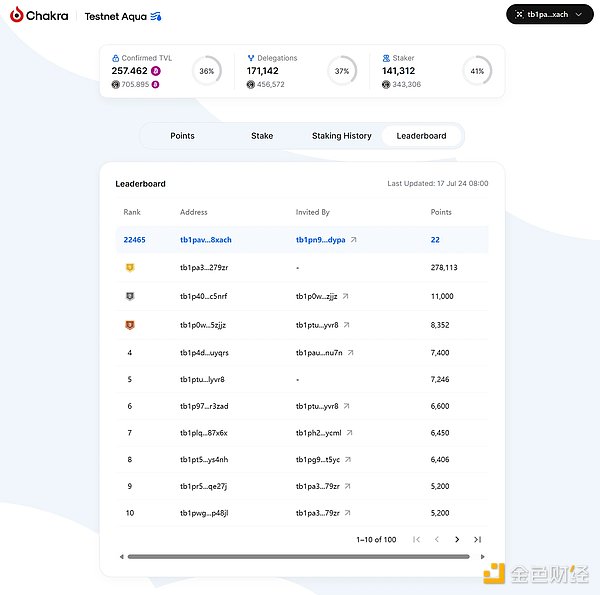
Chakra launched a points system on the test network. For every 0.0005 sBTC pledged per day, 1 point can be obtained. Through invitation, 10% of the invitee's points income can be obtained. The test network supports both self-custody pledge and MPC pledge, and points can be obtained in both pledge methods.
Babylon's BTC staking is also about to be launched. The changes brought about by BTC staking to the BTC ecosystem are huge.
BTC staking first increases the yield of the overall assets, just like ETH's DeFi. At present, the market size of BTC interest-bearing exceeds 10 billion US dollars, and the yield is between 0.01% and 1.25%. The staking rewards of PoS blockchains often range from 5% to 20%. The income from staking BTC to provide staking for other PoS chains can be dozens of times higher than traditional BTC interest. Even if some BTC communities prefer the culture of hoarding coins, the increase in income is real. Users can gain income from using BTC, which overflows to BTC L2 and other ecosystems, and the positive flywheel can be started.
Of course, BTC staking, led by Babylon, cannot be compared with ETH staking, because the BTC chain itself has no native income, but is more similar to eigenlayer's restaking business. The related ecology will also be similar to the LRT protocol under eigenlayer.
Therefore, the monopoly of giants in ETH staking is unlikely to appear in BTC staking, and the motivation for exchanges to exit is also weak, because the scale effect will not lead to more stable profits. Early projects in the field of BTC staking have the opportunity to grab land, and investors can easily get high returns from rapid growth.
This article will cover the details and methodology of the first airdrop of LSD to users of the Liquidswap protocol.
 JinseFinance
JinseFinanceAs the first Layer 2 to focus on developing the LSD track, Metis has broken through the limitations that other Layer 2 networks cannot reach.
 JinseFinance
JinseFinanceIf the Lending platform of the POW public chain is the foundation of the ecosystem, then the LSD protocol of the POS public chain must hold the lifeline of ecological development.
 JinseFinance
JinseFinance JinseFinance
JinseFinance JinseFinance
JinseFinanceIn a recent announcement, Animoca Brands disclosed the inclusion of Ubisoft's upcoming NFT game, Champions Tactics: Grimoria Chronicles, in its Web3 Frequent Player Program.
 Bernice
Bernice JinseFinance
JinseFinanceThe Cardano network has always been a fierce competitor for the Ethereum network.
 Bitcoinist
BitcoinistAt least three blockchain projects have publicly announced that their teams have opened their arms and are ready to accept any former developers who leave after the collapse of the Terra ecosystem.
 Cointelegraph
CointelegraphOn-chain liquidity was the catalyst of DeFi Summer 2020, but what will lead the DeFi markets to hit a trillion dollars within another year or two?
 Cointelegraph
Cointelegraph